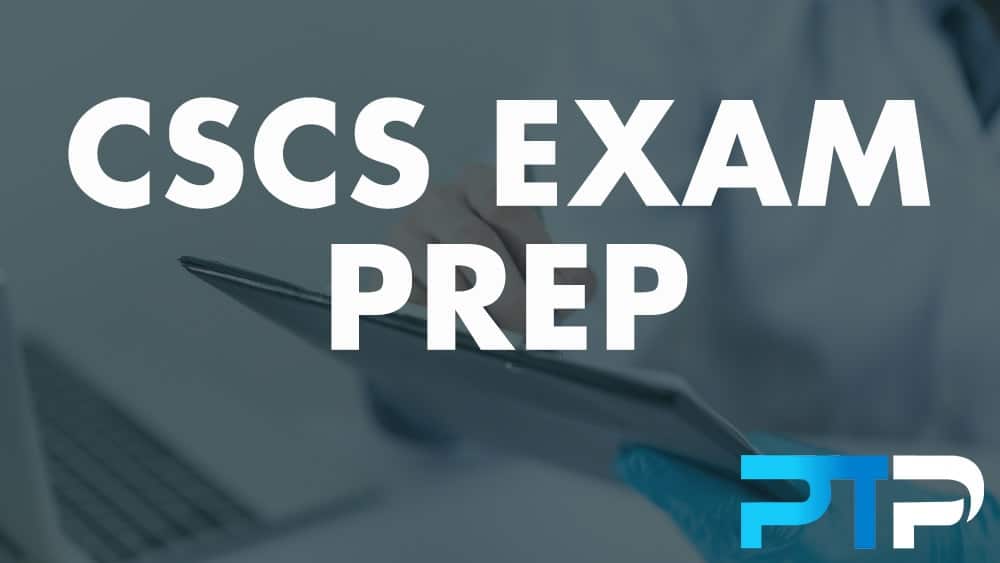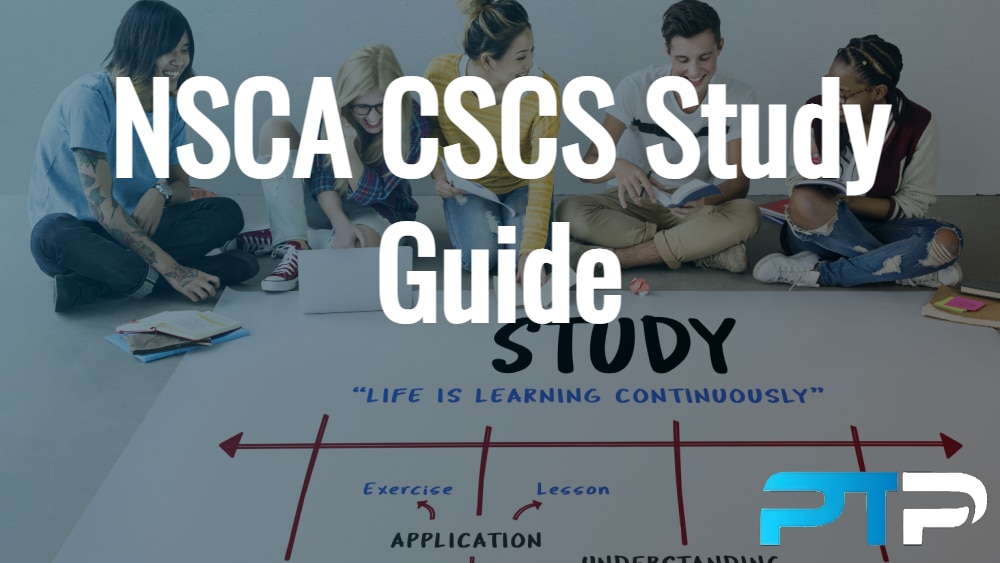
Get your copy of the NSCA CSCS exam cheat sheet. It helps immensely for studying for the exam.
Make sure to check out Trainer Academy for premium NSCA CSCS study materials. They will reduce study time by 50% and have an exam pass guarantee. Read my full review on them here. You can save $100 on their MVP study system with the code: PTPSUB
Chapter Goals
- Learn the macro and microstructure of both muscles and bones.
- Be able to explain the sliding-filament theory.
- Describe both morphological and physiological factors of muscle fiber types. Be able to determine what muscle fiber type is used in each sport.
- Learn the physiological and anatomical characteristics of the respiratory and cardiovascular systems.
Musculoskeletal system
The skeleton
Within the axial skeleton, we have the skull, the vertebral column, the ribs, and the sternum.
The second part of the skeleton is the appendicular skeleton, which includes the shoulder girdle, pelvic girdle, and bones in the body’s extremities.
The three joints of the body: Fibrous, Cartilaginous, and Synovial.
Joints are broken into axes of movement: Uniaxial, Biaxial, and Multiaxial.
There are 7 cervical vertebrae, 12 thoracic, 5 lumbar, 5 sacral, and 3 to 5 coccygeal.
Musculoskeletal macro and microstructure
Every skeletal muscle has muscle tissue, connective tissues, blood vessels, and nerves.
Fibrous connective tissues cover the muscles in the body. They include Epimysium, Perimysium, and Endomysium.
A motor unit comprises a motor neuron and its innervating muscle fiber.
The neuromuscular junction is between the muscle fiber and motor neuron. It can also be called the motor end plate.
Myosin and Actin
Myosin and Actin give skeletal muscles their striated appearance.
The action potential discharging from a motor nerve is the signal that releases calcium from the sarcoplasmic reticulum. This goes into the myofibril and causes tension to develop within the muscle.
The Sliding Filament Theory of Muscle Contraction
The theory states that actin that is present at the end of sarcomeres moves inward toward myosin, and this pulls the Z-lines into the center of the sarcomere. This shortens the muscle fiber.
The Resting Phase: There is not a lot of calcium in the myofibril, so we don’t see many myosin cross bridges bound to actin.
Exclusive PTP CPT Offers |
||
|---|---|---|
Gold Standard Cert | Most Popular Cert | Best Study Materials |
A Good Option | A Good Option | Best CPT for you?  |
The Excitation Contraction Coupling Phase: The sarcoplasmic reticulum releases calcium when it is stimulated. Calcium ions bond with troponin. All of this causes a shift in tropomyosin. Myosin cross bridges attach quicker to actin.
The Contraction Phase: Hydrolysis of ATP occurs and causes contractions of the fibers.
The Recharge Phase: This happens when calcium is available.
The Relaxation Phase: The stimulation stops. Calcium is pumped into the Sarcoplasmic reticulum for use later, thus, actin and myosin cannot link.
The Contraction of a Myofibril
When a muscle is in a stretched position, the H-zone and the I-bands are longer and there is a very low potential for force because of the reduced cross bridge to actin alignment.
During contraction, we see the I-band and H-zone shorten.
Steps of Muscle Contraction
ATP splitting begins and myosin heads become “energized.” This allows movement into position for bonding with actin to the myosin heads.
Phosphate is released from ATP, ad the myosin head changes shape and shifts.
The power stroke occurs as the actin filament is pulled toward the center of the sarcomere.
After the power stroke, myosin heads detach from actin as another ATP binds.
The process is ready to happen again.
The Neuromuscular System
The Activation of Muscles
The amount of control a muscle has depends on how many muscle fibers are within each motor unit.
More precise muscles have as few as one fibers per motor neuron.
Bigger muscles requiring less precision have potentially a few hundred fibers covered by one motor neuron.
The All or none principle: All muscles within a motor unit contract simultaneously; you can’t just use one fiber of a muscle unit. Also, you cannot produce a stronger contraction.
Tetanus is the max force that a motor unit can develop.
Muscle Fiber Types:
Type I: These slow twitch fibers are efficient at using energy and resistant to fatigue, as they have a high aerobic energy capacity. However, they have a low potential for developing a rapid force, thus having low anaerobic power.
Exclusive PTP CPT Offers |
||
|---|---|---|
Gold Standard Cert | Most Popular Cert | Best Study Materials |
A Good Option | A Good Option | Best CPT for you?  |
Type IIa: These fast twitch fibers are inefficient and easily fatigued. They have a low aerobic energy supply but can develop rapid force more easily. Their anaerobic power is high.
Type IIx: These are similar to the Type IIa fibers, but they show less fatigue resistance.
The Recruitment Patterns of Motor Units
Force output changes depending on how many motor units are recruited. One motor unit might be recruited for a more precise activity, thus producing very little force. If a big force is needed, more muscle fibers will be recruited.
How Can Force Production be improved in Athletes?
We can incorporate heavier load training phases so we can optimize neural recruitment.
Increased cross sectional areas of muscles involved in our activity will improve force production.
Performing multi muscle and multi joint exercises done with explosive action can optimize the recruitment of the fast-twitch fibers.
Proprioception
This I the information we receive concerning conscious awareness of where are body parts are positioned in space.
This is all done subconsciously.
Proprioceptors are the sensory receptors we use for this. They provide the CNS with information.
Muscle Spindles
Proprioceptors consist of modified muscle fibers that are closed within a connective tissue sheath.
The stretching of a muscle and subsequent deformation that occurs to the muscle spindle activates the sensory neuron and sends an impulse to the spine. This causes muscle contraction.
Golgi Tendon Organ
These GTOs are proprioceptors located within tendons near the myotendinous junction.
These are placed in a series with intrafusal muscle fibers.
The GTO discharges when we place an extremely heavy load on a muscle.
The Cardiovascular System
The Heart: a muscular organ that consists of two interconnected pumps.
The right ventricle is responsible for pumping blood to the lungs only.
The left ventricle pumps blood throughout the rest of the body.
Valves: Tricuspid, Bicuspid, Aortic, and Pulmonary. Valves close and open passively, dependent on their pressure gradient at the time.
The Conduction system: Control of the mechanical contractions of the heart. Transmission occurs in this series:
- SA Node, AV Node, AV Bundle, Left/Right Bundle Branches, Purkinje Fibers
Electrocardiogram
This is recorded at the surface of the body. It represents a graphical representation of the heart’s electric activity.
- P Wave
- QRS Complex
- T Wave
The Blood Vessels
This is a closed circuit system.
The arterial system is responsible for taking the blood away from the heart.
The Venus system is responsible for the opposite, taking blood toward the heart.
Arteries transport blood rapidly from the heart.
Capillaries exchange oxygen, fluids, electrolytes, hormones, and other substances for blood and interstitial fluid found in the body’s tissues.
Veins are used to collect blood from capillaries and converge to larger veins that bring the blood back into the heart.
Blood
Hemoglobin is the transporter of oxygen. It serves as an acid-base buffer.
Red blood cells take care of carbon dioxide removal.
The Skeletal Muscle Pump
This pump is really the assistance given to the circulatory system by skeletal muscles. The pump works with the venous system. The system contains one way valves that help return blood to the heart. Contracting skeletal muscles compress veins and force blood to flow in the valve’s direction, thus returning to the heart.
The Respiratory System
Air gets distributed by the Trachea, Bronchi, and Bronchioles before finally reaching the alveoli, where gases are exchanged for respiration.
Exchange of Air: Amount of air movement and gases to expire in and out of the lungs. Air exchange is controlled by expansion and recoil occurring within the lungs.
Expiration: The diaphragm relaxes, the lungs’ elastic recoil occurs, and the chest wall and structures of the abdomen compress the lungs. Air is expelled.
Inspiration: Diaphragm contraction causes a vacuum effect in the chest cavity. Air is now drawn into the lungs.
Exchange of Respiratory Gases: The main function of the respiratory system is an exchange of carbon dioxide and oxygen. Oxygen diffuses from alveoli into the pulmonary blood, and carbon dioxide goes the opposite route, blood to alveoli, to expire from the body.
Check out Trainer Academy for the best CSCS study materials. They even offer an exam pass guarantee. They have incredible study materials for the CSCS and I have a special limited-time discount for my readers. I also suggest you check out my review on Trainer Academy here.

 Have a question?
Have a question? 


![FREE CSCS Study Plan, Study Calendar + Blueprint [year] 8 NSCA CSCS Study Plan](https://www.ptpioneer.com/wp-content/uploads/2022/12/NSCA-CSCS-Study-Plan.jpg)

![FREE CSCS Practice Tests [year] - 310+ Practice Questions 10 NSCA CSCS Practice Exams](https://www.ptpioneer.com/wp-content/uploads/2022/12/NSCA-CSCS-Practice-Exams.jpg)

![FREE NSCA CSCS Flashcards [year] - Over 950 Flashcards 11 NSCA CSCS Flashcards](https://www.ptpioneer.com/wp-content/uploads/2022/12/NSCA-CSCS-Flashcards.jpg)


Great materials Tyler, can this NSCA CSCS Cert work on the collegiate and professional level, or is there another certification for those levels?
Hey Fabian, the NSCA CSCS is the gold standard for strength and conditioning and one of the most highly valued at the collegiate and professional athlete levels. Most professionals in that field have this certification. On top of that, the head coaches often have a degree in exercise science/kinesiology or another similar field.
This is amazing, thank you so much Tyler! Is this your own study guide or from ‘CSCS Study Guide from Test Prep Books’ (the popular one on amazon ha) I almost bought that and then stumbled across this!
Hey Krista, this is my own study guide based on over a decade of experience in exercise and working with exercise science certifications. I hope it helps you out, the CSCS is the toughest fitness certification.
Are the materials/chapter guides that you have posted ALL that is needed for the CSCS?
The materials for the CSCS on this site will help guide your studies, but you definitely need the textbook and some NSCA study guides/tests or outside premium study materials like what is offered from sites like Trainer Academy. But I have gathered a lot of study help in these free study materials.
IS this content mostly for the CSCS, or the other certifications too?
Yes, this content is only for the NSCA CSCS certification. If you are planning on studying another certification, make sure to use their specific study materials.
this is a on line are face to face
You will have to go into a testing facility to take and pass your CSCS exam.